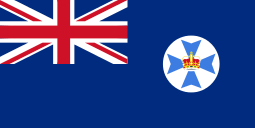Police tactical group
Police Tactical Group (PTG), formerly known as 'police assault group', is an Australian police unit part of the Federal government National Anti-Terrorism Plan[1] which, since 1978, has required each state and territory police to maintain a specialised counter-terrorist and hostage rescue unit jointly funded by the federal government and respective state/territory governments.[2]
The Australia-New Zealand Counter-Terrorism Committee (ANZCTC) defines a Police Tactical Group (PTG) as a highly trained police unit that tactically manages and resolves high-risk incidents, including terrorist incidents.[3]
A PTG directly supports their respective state or territory police in high-risk incidents such as sieges with specialised tactical, negotiation, intelligence and command-support services which are beyond the scope and capability of police generally.[4]
History
Various state and territory police maintained 'tactical' or 'emergency' squads known by varying names consisting of police trained to use specialist equipment and weapons as far back as 1945.[5] These sections consisted mainly of detectives and had limited capability and funding.[6][7] The 1978 Sydney Hilton bombing, where a CHOGM event was being conducted at that time, saw the formation of the Standing Advisory Committee on Commonwealth and State Co-operation for Protection Against Violence (SAC-PAV). Prior to this, Australia had no formal mechanisms to respond to terrorism. SACPAV provided national consistency across all jurisdictions and made several recommendations including that all states and territories maintain a specialist police unit trained for counter-terrorist and hostage rescue situations. These units were initially known as a 'police assault group' in line with the Australian Defence Force nomenclature with their recently created (at the time) Tactical Assault Group. This saw the formalisation of many state and territory tactical units with the standardisation of all police groups in respect to training, equipment and the desired level of response.[8]
In 2001, SAC-PAV was renamed to the National Counter-Terrorism Committee and in 2012 with New Zealand entering to the Australia-New Zealand Counter-Terrorism Committee. [9]
Establishment
The primary providers of law enforcement in Australia are the state and territories. PTGs are police tactical units established to respond to high-risk situations which are beyond the scope or capacity of everyday policing. PTG officers directly support operational police in incidents such as sieges with specialist tactical, negotiation, intelligence and command support services. Each PTG conducts its own training, has the opportunity to train in inter-state courses and may train internationally.
The Australian Federal Police who enforce Commonwealth (Federal) law has a national tactical unit that can be deployed in any state or territory for Commonwealth offences.
Training exercises
A PTG will participate in regular national counter-terrorist exercises (NATEXs), in which federal and state government agencies practise responses to potential terrorist threats and test the procedures and legislation for Australian Defence Force support to civilian authorities in the event of a terrorist attack.[10]
Each year as part of the ANZCTC Police Tactical Group Skills Enhancement Course, each state and territory sends several members of its PTG to participate in a concentrated three-week course with the Tactical Assault Group of the Special Air Service Regiment to strengthen standards of policing in urban counter-terrorist tactics and ensure all states are training consistently to the same codes and standards of counter-terrorism.[11][12] [13]
PTG training is doctrinated, structured and set to a national standard which reduces inconsistent and fragmented training practices. These are designed to allow national interoperability of the PTGs if required. An example of such interoperability was the Port Arthur massacre in which the Victoria Police Special Operations Group deployed to Tasmania to assist the Tasmania Police Special Operations Group. [14]
PTGs undertake training with their counterparts from New Zealand the Special Tactics Group.[15]
Roles
Police Tactical Groups are responsible for a few of the following:
- Resolving siege and hostage situations, as well as armed offender situations;
- Counter-terrorism and hijacking operations;
- The escort and security of VIPs, internationally protected persons, Heads of State;
- Undertaking searches of premises in high risk situations;
- The arrest of armed and dangerous offenders;
- Escorting and securing dangerous prisoners in high risk situations;
Equipment
All groups are jointly funded and equipped by both their respective state or territory police and federal government. Federal government funding allows purchases for more expensive equipment such as Lenco BearCat armoured rescue vehicles. The Australian Government has purchased eight ‘BearCats’ at a cost of approximately $400,000 each—one for each state and territory police tactical group.[16]
State, territory and federal units
-
 Australian Federal Police - Specialist Response Group
Australian Federal Police - Specialist Response Group -
 New South Wales - Tactical Operations Unit
New South Wales - Tactical Operations Unit -
 Northern Territory - Territory Response Group
Northern Territory - Territory Response Group -
 Queensland - Special Emergency Response Team
Queensland - Special Emergency Response Team -
 South Australia - Special Tasks and Rescue Group
South Australia - Special Tasks and Rescue Group -
 Tasmania - Special Operations Group
Tasmania - Special Operations Group -
.svg.png) Victoria - Special Operations Group
Victoria - Special Operations Group -
 Western Australia - Tactical Response Group
Western Australia - Tactical Response Group
See also
- National Anti Terrorism Exercise
- Special Operations Command
-
 New Zealand Police - Special Tactics Group (STG)
New Zealand Police - Special Tactics Group (STG) -
 New Zealand Police - Armed Offenders Squad (AOS)
New Zealand Police - Armed Offenders Squad (AOS) - List of special response units
References
- ↑ National Anti-Terrorism Plan, Sept 2005
- ↑ National Anti-Terrorism Committee
- ↑ http://www.nationalsecurity.gov.au/Mediaandpublications/Publications/Documents/active-shooter-guidelines-places-mass-gathering.pdf
- ↑ http://www.police.nsw.gov.au/about_us/structure/specialist_operations/counter_terrorism_and_special_tactics
- ↑ http://www.austlii.edu.au/au/other/IndigLRes/rciadic/individual/brm_djg/41.html
- ↑ Australian Federal Police Association Journal, v.2 no. 4, Summer 1998/99
- ↑ Dodson, William (2001). The Sharp End: Inside the high-risk world of Australia's tactical law enforcers. Sydney, Australia: Pan Macmillan Australia. pp. 107–109. ISBN 0732910862.
- ↑ E.g., Eastwood, Gary Inside the (Tasmania) SOG Police Association News (Tasmania), June 2011, folio 39 (pdf page 11)
- ↑ "Australia-New Zealand Counter-Terrorism Committee". Australian National Security. Retrieved 10 July 2016.
- ↑ Fact Sheet: Australia's Response to September 11
- ↑ Dodson, William (2001). The Sharp End: Inside the high-risk world of Australia's tactical law enforcers. Sydney, Australia: Pan Macmillan Australia. p. 168. ISBN 0732910862.
- ↑ Defence Annual Report 2001-02, Ch. 2
- ↑ "Review of the Defence Annual Report 2001-02 - Official Hansard - Senate - 11 March 2004" (PDF). Parliament of Australia. Page 21416.
- ↑ Australian Federal Police Association Journal, v.2 no. 4, Summer 1998/99
- ↑ http://www.stuff.co.nz/the-press/news/the-east/9036019/Armed-police-train-in-red-zone
- ↑ New armoured rescue vehicle strengthens Victoria’s counter-terrorism capability at Asia Pacific Security Magazine, 11 April 2013. Retrieved 17 April 2013